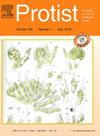Dead reckoning of protist viability with propidium monoazide (PMA)-quantitative PCR; a case study using Neoparamoeba perurans
IF 2.1
3区 生物学
Q4 MICROBIOLOGY
引用次数: 0
Abstract
The ability to distinguish between viable and non-viable protozoan parasites is central to improved human and animal health management. While conceptually simple, methods to differentiate cell viability in situ remain challenging. Amoebic gill disease, caused by Neoparamoeba perurans is a parasitic disease impacting Atlantic salmon aquaculture globally. Although commercial freshwater treatments alleviate AGD, viable amoebae remain on gills or in used treatment water. Existing PCR-based assays are able to quantify N. perurans abundance but cannot discriminate amoeba viability. We investigated the use of propidium monoazide (PMA) application, prior to real-time PCR, to distinguish between alive and dead cells. We demonstrate that 200 μM PMA can significantly reduce amplification from non-viable (isopropanol treated) cultured amoebae across at least three logs of cell concentrations. Using a serial dilution of viable and non-viable cells, we show that non-PMA PCR amplifies both viable and non-viable amoebae, while PMA exposure suppresses (but does not completely inhibit) amplification from non-viable amoebae. The effect of freshwater treatment on N. perurans viability was assessed using the PMA-PCR. Following PMA exposure, amplification from freshwater treated amoebae was reduced by approximately 94–97 %. Taken together this study demonstrates that PMA combined with traditional real-time PCR can estimate amoeba viability.
利用单氮化丙啶(PMA)-定量 PCR 对原生生物的存活率进行死算;以周龄新巴拉米阿米巴为例进行研究
区分有活力和无活力原生动物寄生虫的能力是改善人类和动物健康管理的核心。虽然概念上很简单,但在原位区分细胞活力的方法仍然具有挑战性。由周新巴拉米巴(Neoparamoeba perurans)引起的阿米巴鳃病是一种影响全球大西洋鲑水产养殖的寄生虫病。尽管商业淡水处理可减轻 AGD,但鳃上或使用过的处理水中仍残留着可存活的阿米巴。现有的基于 PCR 的检测方法能够量化 N. perurans 的数量,但无法区分阿米巴的存活率。我们研究了在实时 PCR 之前使用单氮化丙啶(PMA)来区分活细胞和死细胞的方法。我们证明,200 μM PMA 可显著降低未存活(异丙醇处理过的)培养阿米巴在至少三个对数的细胞浓度下的扩增。通过对有活力细胞和无活力细胞进行系列稀释,我们发现非 PMA PCR 可扩增有活力和无活力的变形虫,而 PMA 暴露可抑制(但不能完全抑制)无活力变形虫的扩增。使用 PMA-PCR 评估了淡水处理对 N. perurans 存活率的影响。暴露于 PMA 后,淡水处理变形虫的扩增率降低了约 94-97%。总之,这项研究表明,PMA 与传统的实时 PCR 相结合可以评估变形虫的存活率。
本文章由计算机程序翻译,如有差异,请以英文原文为准。
求助全文
约1分钟内获得全文
求助全文
来源期刊

Protist
生物-微生物学
CiteScore
3.60
自引率
4.00%
发文量
43
审稿时长
18.7 weeks
期刊介绍:
Protist is the international forum for reporting substantial and novel findings in any area of research on protists. The criteria for acceptance of manuscripts are scientific excellence, significance, and interest for a broad readership. Suitable subject areas include: molecular, cell and developmental biology, biochemistry, systematics and phylogeny, and ecology of protists. Both autotrophic and heterotrophic protists as well as parasites are covered. The journal publishes original papers, short historical perspectives and includes a news and views section.
 求助内容:
求助内容: 应助结果提醒方式:
应助结果提醒方式:


